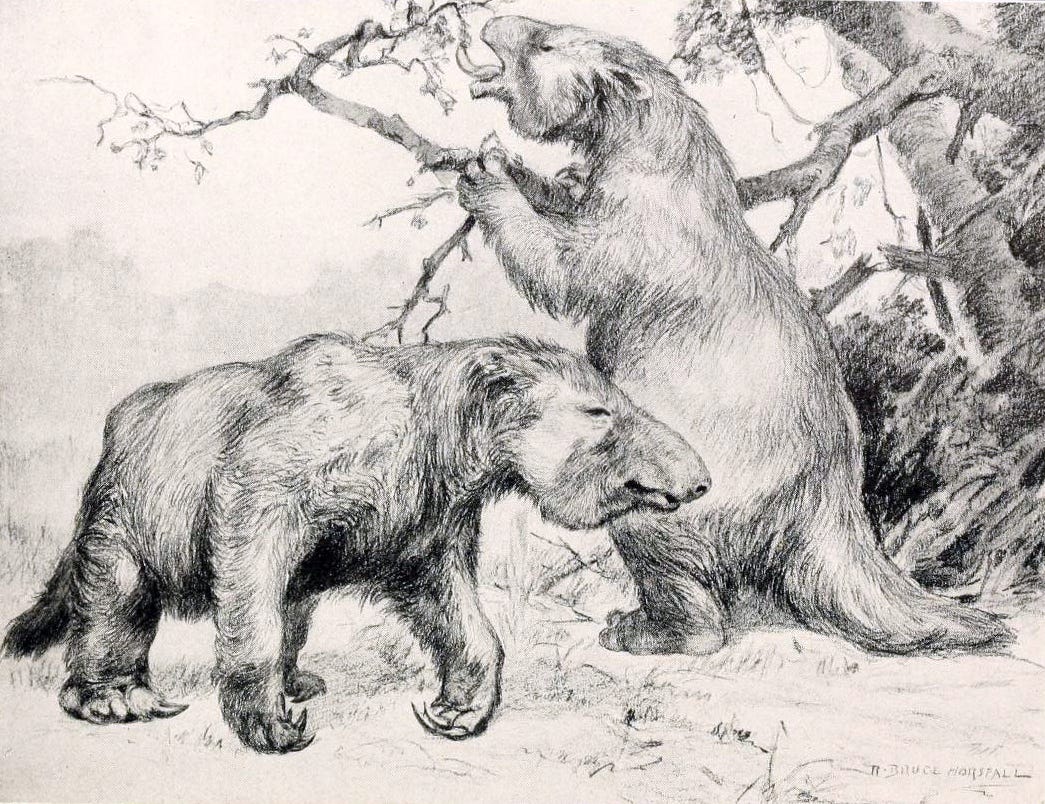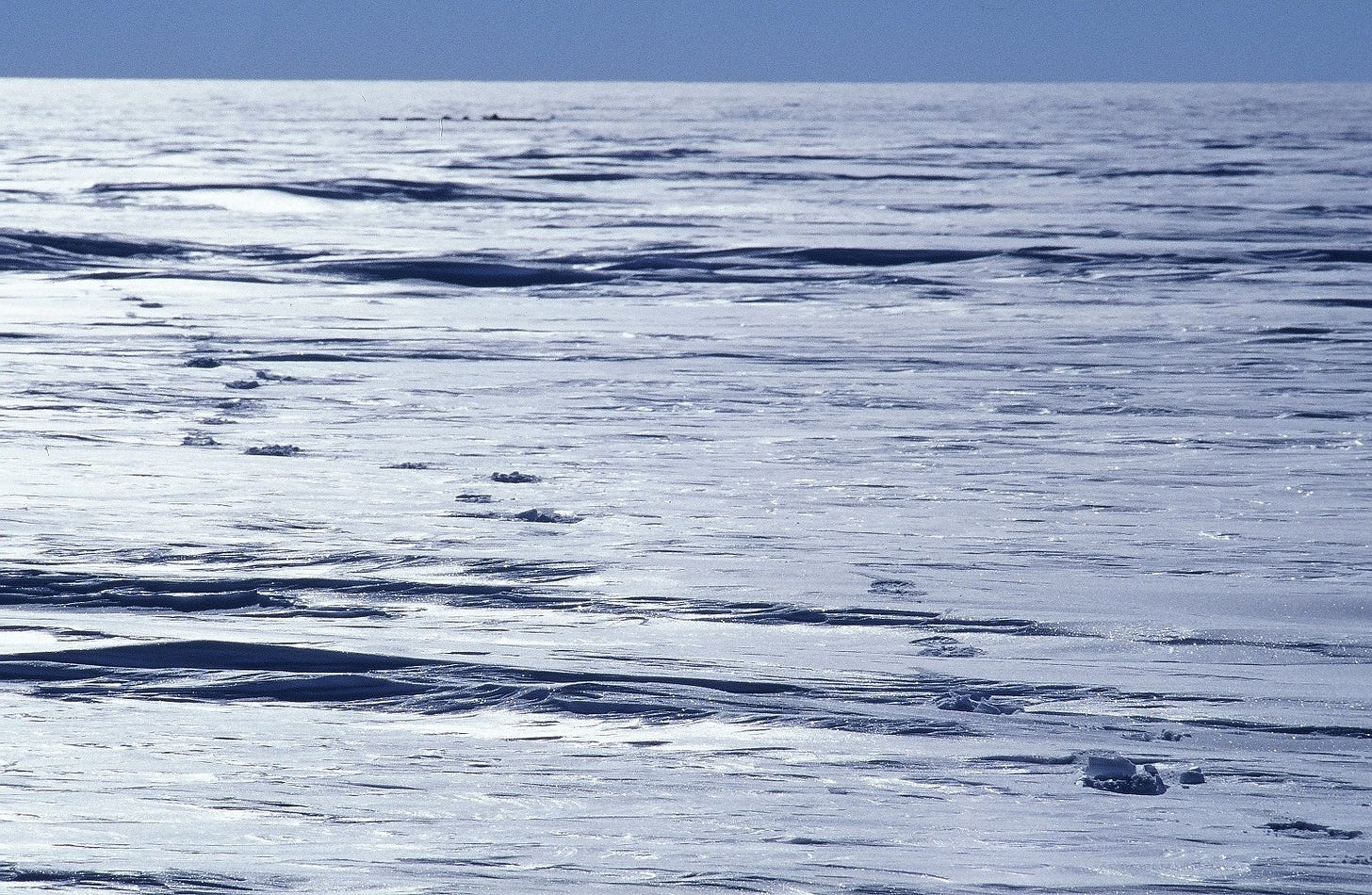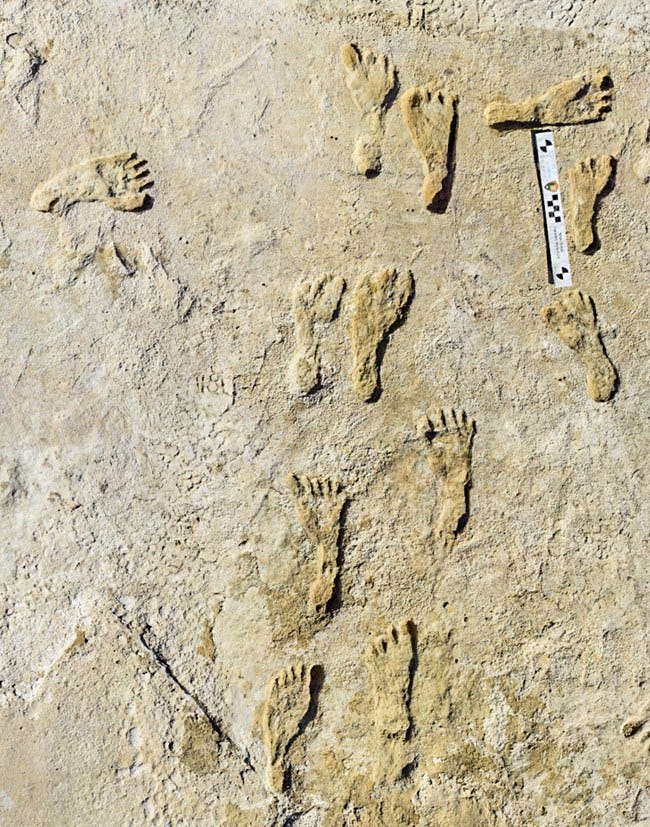
I’m away this week, on a road trip to visit family. I’ll leave you with a slightly reworked essay – “It’s About Time” - I wrote in June of 2021. Many of you are new readers of the Field Guide and, unless you’ve been thoroughly exploring the archives, have not seen it. For those of you who read it a year and a half ago, I think it's worth a second look.
As always, please remember to scroll past the end of the essay to read some (new) curated Anthropocene news.
Now on to this week’s writing:
Thinking about the Anthropocene leads me, in various ways, to thinking about the nature and perception of time. Most notably, humans have become the equivalent of a supervolcano, pulling millions and millions of years’ worth of stored carbon out of Earth’s root cellar and cooking it all at once. After just a couple centuries, atmospheric CO2 is at a level not seen for fifteen million years. Our disruption of the carbon cycle (and the nitrogen cycle and the phosphorus cycle) is not unnatural, but it is unnaturally quick. It’s instantaneous in geological terms, really.
In other words, the climate crisis is a function of compressed time, like a few bottles of gin poured down someone’s throat rather than being enjoyed slowly, shot by shot, with ice and lime and tonic over a summer’s worth of hot evenings. The dose, as Paracelsus said, makes the poison.
As chattering social apes, we’re poorly equipped to think in terms of a million years, much less eons or eras. We’re apparently unique in our capacity to do the math, to make the metaphors and maps, and to imagine the idea of deep time, but we don’t inhabit it. We barely contemplate – beyond a Wow and a pause – the 2000- to 3000-year lifespans of giant redwoods and sequoias now suffering the consequences of a rapidly changing climate.
In this way, we are not unlike the marvelous African dung beetle which navigates by the Milky Way on moonless nights. We have made a sophisticated tool out of our mapping of geological time, but our relation to the ages we have mapped is as ephemeral as that of the dung beetle to the galaxy.
One of the glories of the scientific process is its capacity to build knowledge of the world beyond our sensory and temporal limitations, but the great ever-growing monument of data is, in the end, still being provided for an audience of hormone-addled chattering social apes. We’re far more interested in the socially useful products of applied science (smartphones, combustion engines) than we are in the processes of pure science, e.g. the math behind astrophysical or biogeophysical theories. So, when a Grand Canyon interpretive sign says “Here’s how we figured out that the deepest rock in the canyon is 1.8 billion years old!”, more often than not we walk on with our companions to the view at the edge of the cliff.
That view of deep time from the edge of the cliff is my topic today, or really it’s my way of introducing you briefly to three books I highly recommend: Apocalyptic Planet by Craig Childs, Footprints by David Farrier, and Ends of the World by Peter Brannen.
Yes, it’s a few white guys gallivanting around the world to parse the damage done by a couple centuries of white guys gallivanting around the world… but the books are beautiful and the work is important.
Before I dive in, though, I want to talk for a few paragraphs about Antarctica, where (as yet another gallivanting white guy) I had the great good fortune of spending much of a decade in Antarctica. Most of that time was spent in a busy base on the coast, with a few astonishing months spent on a glacier in the ice-drowned Transantarctic Mountains, but it was the fourteen weeks or so I spent on the ice caps, on a few trips over a few years, that are most relevant to this discussion.
Let me set the stage: Imagine you and a companion are sailing in a small boat across a great lake larger than Australia, with no land for hundreds of miles: then imagine the world suddenly freezes solid. Waves are frozen in place, as is the two to three miles of water beneath you. Now put on a parka, step off the boat, and walk across the snow-dressed undulating ice. You are alone in this void, other than some hapless microbes blown in on the jet stream. Turn around to see your boat turned into a small tent, and that’s the experience of the Antarctic ice cap.
Spend a few weeks shuffling around that tent while the sun circles relentlessly overhead and a perfect circle of horizon barely divides ice from sky, and you’ll find that time and space start to feel like different forms of imagination. There is no sound other than wind rustling your clothes and whispering a thin veil of ice crystals past your ankles. You’ll feel at moments like a fly buzzing around the moon. Close to the South Pole, the day is six months long, while beneath your feet are millions of years of ice accumulated one snowflake at a time.
There is, in such an abstract landscape, an overwhelming perception of timelessness. For me the perception was mostly illusion, in the sense that I was still a chattering ape with a biological clock and a work schedule, but I knew also – and still know – that the cold heart of Antarctica gave me a rare gift: a peek through the fence of biological perception, beyond the constant birth-and-death-cycle of short lives. Here was a place of vastness and emptiness and yet my smallness within it felt intimate, like an invitation into the universe.
Which is to say that sensory starvation and metaphor can make a fine introduction to deep time if you inhabit a deep elemental wilderness long enough. You should try it sometime.
Which brings me to Craig Childs, who is an astonishing traveler and narrator of the hard places. A deep guide and a sunburnt interpreter, Childs in Apocalyptic Planet takes us to the deserts of Sonora and Atacama, the icefields of Patagonia, the shore of the Bering Sea, the Greenland ice sheet, Tibet, Hawaii, and the biological desert of an Iowa cornfield. His thought on the feeling of smallness in vast geography is hard-earned and wise. It’s not really smallness, he says, it’s confusion: “You are starting from scratch here, seeing the world as it is, not so much as you imagine it.”
Child’s notion of “apocalypse” is rooted both in the ancient meaning – revelation, or the lifting of a veil – and the current definition: widespread destruction. Acutely aware of the stirrings of a sixth mass extinction, Childs also understands the planet has always been in flux:
Conditions will not remain as they are. That is a guarantee. They never do. In the geologic past, deserts have swallowed the globe, and most of the planet has been infrequently locked in ice, equatorial seas bobbing with slush… Our own relatively moist geologic era of the Holocene has gone on for about ten thousand years, and yet it is only a sliver. Current conditions represent about 10 percent of what the earth has been like over the last three million years.
The revelation part of the book is his quest to experience firsthand those places which evoke the Earth in flux: the intensifying desert, the shrinking glacier, the rising sea:
Wanting to know what the end is made of, I went there. In the company of lava, ice, and blowing desert sands, I worked to see beneath the surface appearance of things and stand in the presence of apocalypse.
It’s a journey out of human time and into the great rhythms of Earth time.
And Childs travels it beautifully and wisely. He is as comfortable moving barefoot through the Sonoran desert as he is articulating the meteorology of a warming planet. He is as honest about the odds of us successfully geoengineering the climate in order to protect the Greenland ice cap as he is about his desire to walk blindly across it:
Being this detached from anything solid was a sensation so large and seamless I could only equate it with being an infant… I saw the world so clearly, so fresh.
And Childs even manages to be insightful in the midst of suffering for days in a July heatwave – heat index around 120° F – in an Iowa cornfield. Once a lush and biodiverse North American grassland, it’s now an Anthropocene landscape far less hospitable to life than a desert or ice cap. “This was not the soil that farmers were pinching a century ago, nothing like it,” he writes. “This was now a created substance, an anthropogenic substrate.” Wherever Childs travels, he enriches the ground he walks on.
Where Childs travels (and writes) with muscle, David Farrier moves with a Scottish academic’s quiet confidence. In Footprints: In Search of Future Fossils, Farrier reaches to his literary bookshelf as often as he does the annals of Anthropocene science. He travels the world musing on what will remain of our current civilization at the far end of deep time, as we now look back in the geologic record for traces of the life forms of earlier eras.
I opened Footprints expecting a polite tour, but Farrier surprised and delighted me from the opening pages, where he connects the brief exposure of 850,000 year old early human footprints on the English coast with the nearly simultaneous “landmark” of atmospheric CO2 reaching 400 ppm for the first time in human history. The footprints were washed away by the tide within two weeks. Likewise, he says, “We are conjuring ourselves as ghosts who will haunt the very deep future.”
Farrier writes about our 31 million miles of roads built around the fairy tale of endless oil, which we’ve extracted without concern for endless consequences. He notes that shipping lanes have created shadow roads beneath the sea with their linear debris fields of clinker (coal residue) and plastics and, occasionally, ships themselves.
He visits the bustle of Shanghai to imagine it flattened to a thin smear millions of years hence. After citing writers William Golding and Ursula Le Guin and philosopher Roland Barthes, Farrier writes a virtuoso chapter imagining the hero’s journey of a disposable plastic bottle, from its origin as a phytoplankton bloom 145 million years ago through its transformation into oil and then plastic and then ocean waste, circling and degrading and contaminating before finally sinking and disintegrating into the sediments at the end of a long, strange circular life.
I was perhaps most moved by Farrier’s chapter-length inquiries into the disappearing world of ice (“The Library of Babel”) and our impact on microbial life (“The Little God”). Antarctic ice, he notes, was recording our presence long before we knew Antarctica existed, and now that science can peer into every season of every year (going back hundreds of thousands of millennia) through the library of ice cores, we are caught in the irony of studying our modern traces in the ice even as the source of those traces is melting the ice.
It’s like sitting in the reading room of the library of Alexandria reading about its burning, and suddenly smelling smoke.
The “microbial Anthropocene” is “a story of extinctions within extinctions, and interventions into evolutionary time itself.” Microbes drive evolution, but as we eliminate and alter habitat, and erase species, we shape the invisible world too. As biodiversity declines so does microbial biodiversity. Perhaps our biggest impact is in the flood of antibiotics into the world. One study found “up to one hundred million antibiotic-resistant genes per gram of mud in Chinese estuaries.” Thinking about this while reading the exquisite ways Farrier explores the topic, has expanded my sense not just of the Anthropocene but also of the nature of a mass extinction.

Earth’s history of mass extinctions are the subject of Peter Brannen’s excellent The Ends of the World, which he articulates through deep research and extensive interviews with the scientists who have spent their careers studying them. He is a brilliant science journalist with a sharp sense of humor, and so the prose falls somewhere between Childs and Farrier: neither grizzled nor high-literary, yet often wry and insightful:
Life on earth constitutes a remarkably thin glaze of interesting chemistry on an otherwise unremarkable, cooling ball of stone, hovering like a sand grain in an endless ocean of empty space.
That glaze of life is remarkably resilient, but it has to be. The planetary forces at work are as likely to burn, drown, dehydrate, or freeze it as to allow long periods of lush evolutionary growth like the one that has nurse humans into being.
The End-Ordovician Mass Extinction, the Late Devonian Mass Extinction, the End-Permian Mass Extinction, the End-Triassic Mass Extinction, the End-Cretaceous Mass Extinction, and the End-Pleistocene Mass Extinction: These six horror-novel chapters in Earth history are chapters in Brannen’s book. What connects the first five, which are the worst five, is that they “have all been associated with violent changes to the planet’s carbon cycle.”
Supervolcanos, Snowball Earth, acidic seas, and a reduction of ocean biodiversity to “microbial slime”: these are just some of the results of turning up or down the carbon dioxide machine. The echo of today’s climate crisis is intentional. Brannen points out that the scientists devoted to using the fossil record to puzzle out Earth’s previous upheavals are doing so in large part because they see parallels in the upheaval we’re causing. Mapping the past gives us a map of options for the future.
That future begins in this context at the sixth extinction I listed above: the End-Pleistocene. That’s just fifty thousand years ago, a blink. That extinction is not like the others, at least not yet. It’s ours, the one we’re still determining, the one we’re now calling the Anthropocene because we’re focused on the modern acceleration of human impacts.
But fifty thousand years ago, an odd pattern of disappearances occurred, “the biggest hit to large land vertebrates since the biblical chaos at the end of the Cretaceous.” The pattern was early human migration, and the extinctions only occurred to large, slow, tasty megafauna like giant kangaroos or giant sloths. There’s no similar record of losses of plants or marine life.

Now, though, as we’ve ramped up from hunting prowess to supervolcanic CO2 production, every branch of life is on the line. We are nowhere near being in the midst of a mass extinction like the end-Permian – the worst of the worst, when nearly all life on Earth died out – but we seem to be setting the stage. The end-Permian period only took about sixty thousand years. After that wildly destructive blink in the geologic record, there’s a ten-million-year gap before trees appeared again.
Brannen teaches us that even a garden-variety mass extinction will take hundreds of thousands of years to balance out the carbon cycle, a hundred thousand years for the oceans to de-acidify, but millions to tens of millions of years to correct for the crash in biodiversity.
We know how we got here, and thanks to the work of countless scientists, and to writers like Childs, Farrier, and Brannen, we have a story of where we’re going, more or less. It’s not theoretical, as Brannen points out:
Our current experiment – quickly injecting huge amounts of carbon dioxide into the atmosphere – has in fact been run many times before in the geological past, and it never ends well.
Thanks for sticking with me.
In other Anthropocene news:
From The Overpopulation Project, four success stories of rewilding landscapes in Europe – Portugal, Croatia, Germany/Poland, Ukraine/Romania – thanks in part to the slow and steady decrease in European population. Some of you will remember a recent link I shared from Our World in Data about the heartening rebound of mammals across that region. For a more comprehensive look at rewilding work being done in Europe, check out the Rewilding Europe organization behind many of the projects.
From Vox, a welcome assertion, with seven good reasons, that life on Earth might not be doomed.
For a counterpoint from the Intercept, you can get some dark humor and darker conclusions about the fate of everything, in an article called “Merry Christmas! We’re All Being Murdered by Capitalism.” Read only if you want to scratch that pessimistic itch.
For more standard hard news, from Slate we have a report on the worsening problem of microplastics in the oceans, now are commonly found in the digestive systems of plankton, the foundation of the food chain.
And this from Live Science: Greenland’s ice sheet is melting 100 times faster than expected.






Brennan's book is brilliant- I own a copy and have reread it several times and recommend it to others. But so are your essays which I've treated identically. Recommend to you just about anything by Peter Ward. Under a Green Sky is sobering.